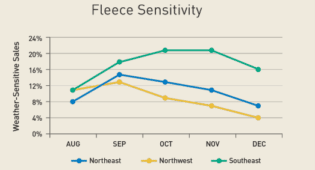Weather & Retail Myth #3: Consumers Will Shop During the Holidays Regardless of the Weather
Just because sales peak for many retailers during the November-December holiday sales period doesn’t mean weather’s business impacts disappear. During the holidays, weather not only influences if a customer goes into a store, it also influences the items they place in their basket.
For example, 18 percent of boot sales are influenced solely by the weather in December, while specialty apparel stores see sales fluctuate up to 4 percent on average, depending on weather conditions and location. Even a fluctuation of a few percentage points in sales is significant for any retailer during the highest volume months of the year.
When and where those weather-driven demand changes occur directly affects profitability. Slower sales earlier in the season often lead to earlier and/or steeper markdowns. Conversely, there is a much better likelihood of maintaining profits if the season starts strongly and inventory moves briskly.
Even hardware stores and home centers, which have their “holiday” season in the spring, feel the impact. In fact, December is the third most weather-sensitive month of the year (on a percent of sales basis) for this sector. Winter conditions bring shoppers in for ice melt and snow removal products; warmer and drier weather can extend windows for DIY projects and boost demand for outdoor lighting and holiday decorations.
Check out the 5 Myths About the Weather & Its Impact on Retail from the NRF to learn more.

